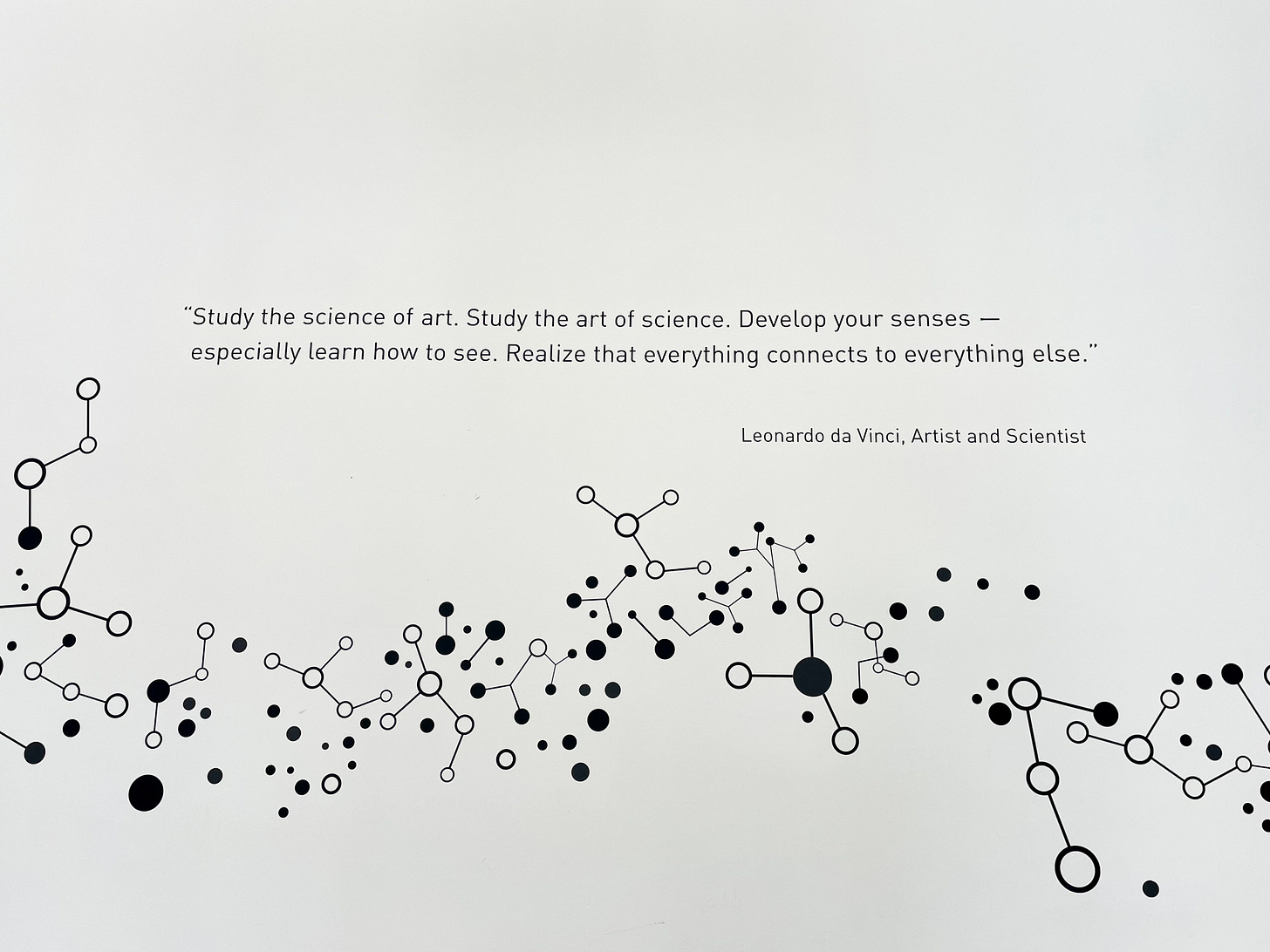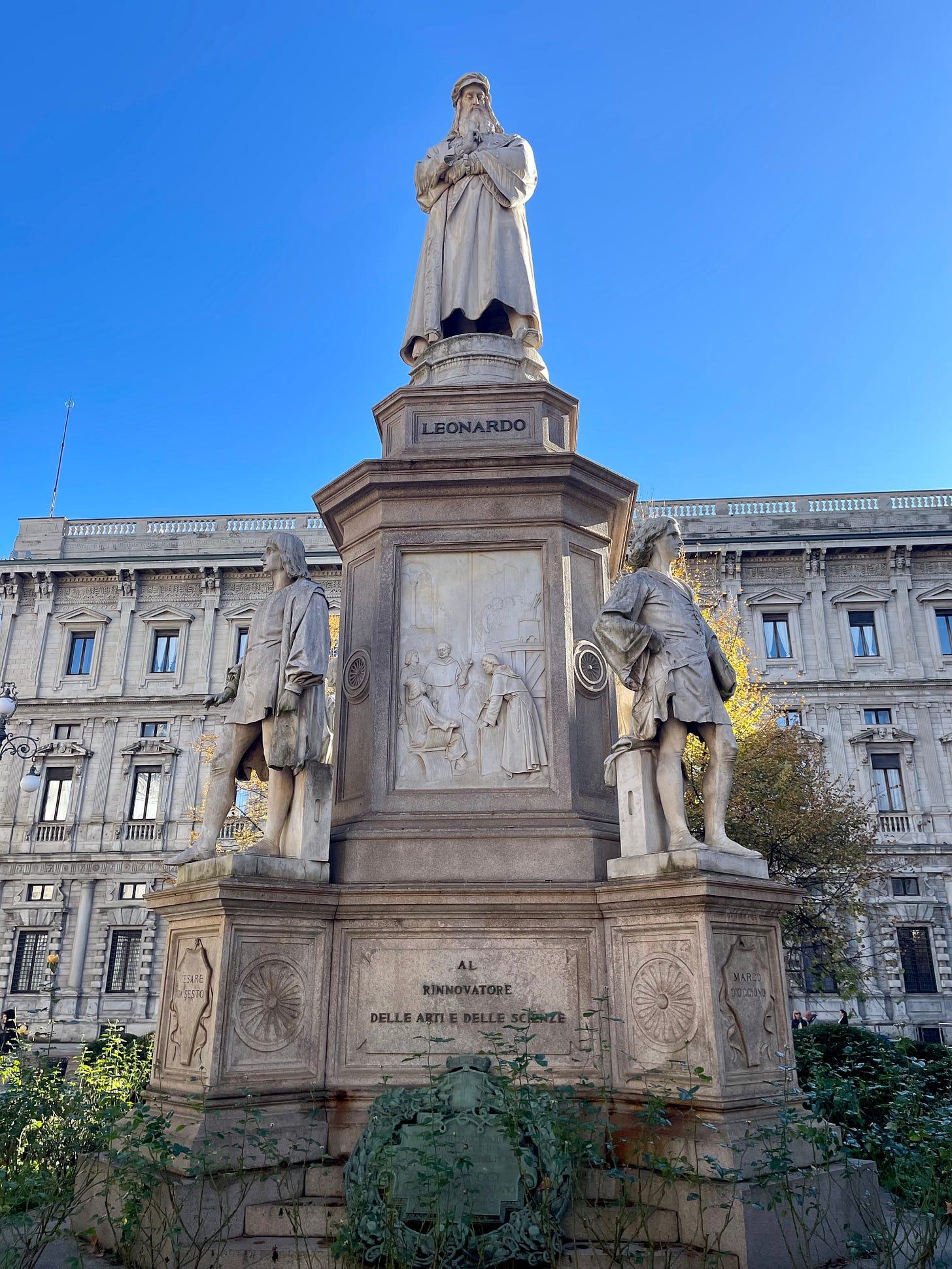The Science of the Last Supper
Surprising facts about Da Vinci's masterpiece
I just returned from a two week “work-cation” in northern Italy with Lenore. In addition to enjoying copious pasta and wine, we toured around some of the major sites of the Renaissance. One of these was the Santa Marie delle Grazie convent in Milan, which houses Leonardo Da Vinci’s masterpiece “The Last Supper,” painted in the late 15th century. This work stands as a testament to his genius not only as an artist but also as a scientist, and it remains an influential piece of art history to the religious and secular alike.
Like most people, I have seen photos and reproductions of the painting everywhere since I was a kid. What you can’t appreciate until you see it in person is how HUGE it is! Unlike the “Mona Lisa” or many of his other works, it is not painted on a normal-sized canvas, but rather occupies a massive space on a vertical wall within the church. This large size and unusual medium necessitated innovative techniques invented by Da Vinci specifically for the piece, and encapsulates a blend of artistic innovation and scientific inquiry. Let’s explore some of the interesting facts that I learned about “The Last Supper” after visiting it in person (with the help of an art history guide).
A Novel Technique
Da Vinci's choice of materials and technique for "The Last Supper" was unconventional. Unlike traditional fresco painting, which involves applying water-based pigments on wet plaster, Leonardo invented his own approach to painting on a dry wall. He used a method (now known as “a secco”) akin to tempera painting, mixing pigment with a binder like egg or oil, allowing for greater detail and layering. This provided him with more time to work on the details but had a significant drawback: the paint did not adhere well to the wall, leading to deterioration over time. Da Vinci's pursuit of perfection and his willingness to experiment with materials and techniques showcase his blend of artistic vision and scientific experimentation.
Perspective and Waves
Beyond innovation in painting materials, Da Vinci's use of perspective in "The Last Supper" was also groundbreaking. He employed a technique known as linear perspective, where parallel lines converge at a “vanishing point” in the distance, creating an illusion of depth. That point aligns directly behind Christ's head, making him the focal point and reinforcing his central role in the narrative of the painting. All of the proportions and spatial arrangements in the painting are carefully calculated to create a harmonious and balanced composition in keeping with the Renaissance fascination with geometry and symmetry.
Additionally, recent studies suggest that da Vinci may have incorporated sound wave patterns into the layout of the disciples and their gestures. An Italian musician and computer technician, Giovanni Maria Pala, interpreted the placement of hands and loaves of bread as a musical notation. When read from right to left, as Leonardo was known to write, these elements form a 40-second composition, hinting at the possibility that Leonardo embedded hidden music in his artwork:
The Science of Restoring A Masterpiece
Over the centuries, "The Last Supper" has undergone numerous restorations to combat damage from environmental factors, war, and the painting's inherent fragility due to Leonardo's experimental technique. The most extensive restoration began in 1978 and took over 20 years. Conservators employed microscopic examinations, infrared reflectoscopy, X-ray fluorescence, and other diagnostic techniques to understand the original layers of paint and Leonardo's technique. Guided by this information, they used solvents and micro-tools to carefully remove dust, grime, and previous restoration materials, restore faded colors, and stabilize the artwork. This restoration revealed details previously lost and helped in preserving this masterpiece for future generations. To protect the painting from future environmental damage, climate control systems were installed to stabilize temperature and humidity levels in the dining hall of Santa Maria delle Grazie where the painting resides. Each phase of the restoration sparked debates among art historians and conservators regarding the techniques used and the extent of intervention, but the guiding principle has always been to preserve the painting without altering its original appearance or composition.

A Lasting Testament to Da Vinci’s Genius
Leonardo da Vinci's "The Last Supper" is not only one of the most famous paintings in the history of art, but also a cultural and historical landmark with a profound and enduring legacy. It is a quintessential example of Renaissance art, embodying the era’s emphasis on humanism, realism, and a scientific approach to perspective and anatomy. Scholars continue to examine its artistic techniques, thematic content, and historical context, and it attracts millions of visitors and art enthusiasts to Milan every year. Da Vinci’s painting remains a modern icon, inspiring reproductions, parodies, and references in various media, from films to advertising. His innovative techniques, exploration of perspective and possibly sound, and the ongoing scientific efforts to preserve his work, all contribute to the enduring legacy of this remarkable painting. For anyone who has the opportunity to visit Northern Italy, I highly recommend making the trip to see it in person!





So fascinating! I’m not an art person, but something about the way you wrote this drew me in. I’m astonished by how artists can work in these multi-dimensions and not lose the forest for the trees. It’s mind-blowing. I feel the same way about choreographed group dances. These people’s minds work in ways mine does not.
Very cool thanks for sharing this!
I always find the speculation about secret codes and symbols in this painting fascinating, too. I don’t have time to get into it now, but when researching the V shape, and (?) Mary Magdalene to Jesus’s right, I stumbled upon this website that trying to debunk all of that and more. I think there is a lot of truth in the symbolism, and this debunking sounds way less likely!
https://www.catholicbookwriter.com/dv_qa.htm